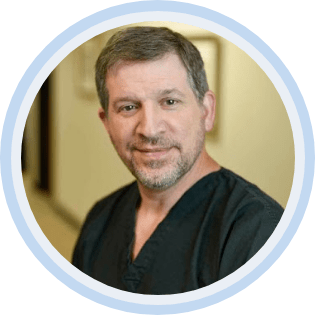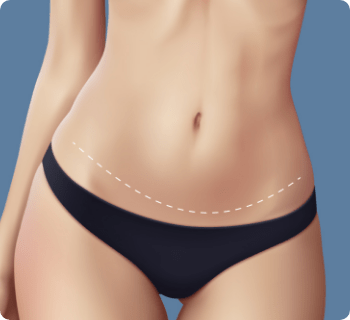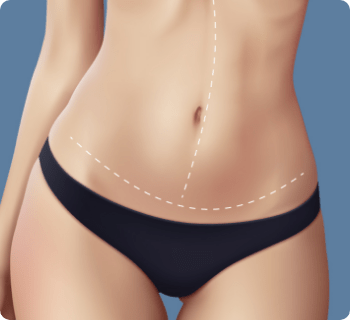Tummy Tuck
Stretched, excess skin accumulating in the abdomen is a cosmetic issue for numerous women and men. While genetics and the natural process of aging can play a role in—or even be the sole cause of—its occurrence, this aesthetic concern is most commonly brought on by significant fluctuations in weight, including those experienced during and after pregnancy.
When the size of the abdomen increases with weight gain (and/or a growing baby), the skin throughout the region also expands. In the event this added abdominal volume is subsequently lost—whether through traditional weight loss means, bariatric surgery, or childbirth—the skin may shrink to some degree, but it does not always return to its original state. This often leaves behind an accumulation of redundant, sagging tissue that does not respond to diet and/or exercise. Additionally, depending on how quickly and to what extent the weight was gained, the abdominal musculature may be stretched or even separated, and stretch marks might also be visible.
Fortunately, individuals experiencing these issues can often address their concerns and achieve an improved abdominal contour via tummy tuck surgery.
What Is a Tummy Tuck?
Tummy tuck surgery—medically referred to as abdominoplasty—is an aesthetic procedure designed to remove excess, hanging skin and repair stretched and/or torn abdominal muscles for a leaner, more toned abdomen. Depending on their location, stretch marks in the region can often be eliminated, and liposuction may be utilized to remove additional stubborn pockets of fat for an improved overall appearance in the midsection.
Dr. Steven Holzman, our board-certified plastic surgeon, has over 20 years of experience in customizing abdominoplasty to meet the unique needs and goals of the individual, and his extensive surgical training and knowledge of anatomy help to ensure an exceptional outcome. In fact, tummy tuck surgery is one of his most frequently performed and most satisfying procedures. Our patients who have undergone abdominoplasty are generally thrilled with the results and are amazed with the dramatic transformation of their midsection that would have not been attainable without surgery—which is where Dr. Holzman’s experience truly counts.
Who Is a Candidate for Tummy Tuck Surgery?
Ideal candidates for tummy tuck surgery are generally women and men who desire one or more of the following:
- To remove stretched, redundant skin in the abdominal region
- To tighten stretched and/or separated abdominal musculature
- To eliminate abdominal stretch marks (depending on location)
- To get rid of a belly “pooch” following weight loss or pregnancy
- To relieve back strain caused by the weight of excess abdominal skin
- To achieve an improved overall midsection contour
- To boost comfort and confidence when wearing various articles of clothing, including bathing suits
Good abdominoplasty candidates are also healthy, they are at—or very near—their desired weight, and they have realistic expectations for what can be accomplished through surgery. Smokers and/or tobacco users will need to quit at least four weeks before treatment, preferably with no intention of resuming the habit(s) afterward.
Dr. Holzman can further discuss these candidacy requirements (as well as any others that pertain specifically to your case) during a personal consultation, helping you to decide if tummy tuck surgery is the right procedure for you.
“Very professional, understanding, and helpful. He backs up his work and will provide reasonable continuing care, at no extra cost. Prices are reasonable and he has the experience you want, without being closed-minded.”
Can a Tummy Tuck Repair Diastasis Recti?
In addition to the aesthetic benefits of a tummy tuck, it can also be employed to help repair diastasis recti. Diastasis recti refers to a condition where the left and right sheaves of abdominal muscles separate, creating a gap. This can often create a “pooched” or distended belly appearance. It commonly occurs in women after pregnancy, especially in those who have had multiple pregnancies. This makes abdominoplasty a popular procedure to include as part of a comprehensive post-pregnancy mommy makeover. However, diastasis recti can happen to anyone of any gender, and additional potential causes include obesity and abdominal muscle strain. Many cases of diastasis recti resolve on their own, but some may be permanent. Left untreated, diastasis recti can lead to lower back pain, pelvic pain, constipation, poor posture, and—in extreme cases—hernias. A tummy tuck can help tighten and repair the muscles of the abdomen, providing a smoother, flatter, and tauter abdominal appearance while also restoring the muscles to their proper positions.
What Does the Tummy Tuck Procedure Involve?
The specifics of your tummy tuck procedure will depend on the particular technique employed (as described above), as well as your unique needs and aesthetic goals. That said, most abdominoplasties involve lifting the skin and fatty tissue off the abdominal muscles, tightening the underlying muscles, and removing the saggy, excess tissue. Excess fat in the treatment area(s) is also sculpted—sometimes using liposuction techniques—to create more proportional contours and a smoother silhouette. If stretch marks are located on areas of skin that are excised, they will be eliminated.
Standard and fleur-de-lis tummy tucks usually take anywhere from two to four hours to complete, and most patients are able to return home later the same day. The circumferential abdominoplasty typically takes five to six hours in the operating room, and it generally requires an overnight stay at a full-service hospital because of the more extensive nature of the surgery.
Can I Get a Non-Surgical Tummy Tuck?
While there are a number of procedures that claim to offer non-surgical body sculpting, none of them can offer the same degree of abdominal rejuvenation as a tummy tuck. Most minimally or non-invasive procedures work by targeting and eliminating excess fat, but they are unable to address the excess skin and musculature that make tummy tucks such a sought-after procedure. In cases where a patient is either at or near their desired weight and level of fitness, non-surgical body contouring procedures or liposuction may be able to adequately address small pockets of excess fat in targeted areas. However, for patients struggling with excess skin, diastasis recti, or other structural concerns, a surgical tummy tuck is the best option for comprehensive abdominal rejuvenation.
What Is Recovery After a Tummy Tuck Like?
After abdominoplasty, Dr. Holzman will follow you closely in the postoperative period to see that you are healing well and are medically stable. Generally, there will be a weekly visit for the first three to six weeks, and then less frequently after that until you are completely healed and satisfied with your results. Most non-strenuous jobs and daily routines can usually be resumed after about one to two weeks when a standard or fleur-de-lis tummy tuck is performed, and after about two to four weeks when a circumferential abdominoplasty is performed. The level of discomfort experienced throughout recovery will vary by individual and extent of the operation, though medication can typically help keep any potential pain under control.
Full results from tummy tuck surgery are not generally seen until six months postoperatively, but you can expect to start shedding your old wardrobe and fitting more confidently into your desired clothing almost immediately—perhaps even a smaller size. Ultimately, Dr. Holzman will share in the joy as you enjoy your new body, revive your personal life, exercise without discomfort, fit into new clothes, and become more confident.
How Long Will My Tummy Tuck Results Last?
The results of a tummy tuck are designed to be long-lasting, providing abdominal rejuvenation for many years to come. That said, there are certain lifestyle habits that can help promote the longevity of the procedure. These include maintaining a relatively stable weight, eating healthy foods, and exercising regularly. By taking good care of your body and avoiding weight fluctuations, you can help maximize your tummy tuck results and maintain a smoother, slimmer abdomen over the long-term.
What Will My Tummy Tuck Scars Look Like?
Scarring is an inevitable part of any surgical procedure, and the precise look of your tummy tuck scars will vary based on the technique used. That said, Dr. Holzman is a highly-experienced plastic surgeon with extensive knowledge of how to place scars so that they blend in as closely as possible with your natural body contours. A standard tummy tuck involves a horizontal scar that runs from hip to hip along the bikini line. A fleur-de-lis abdominoplasty involves a more significant scar that runs both horizontally across the bikini line and vertically up the abdomen. A circumferential tummy tuck typically entails a scar that extends horizontally around the lower body and abdomen.
The greater amount of scarring associated with the fleur-de-lis and circumferential techniques enables them to provide more dramatic slimming, smoothing, and tightening results. Dr. Holzman will carefully discuss the potential scarring associated with treatment during your consultation, and he can help you decide which procedure best meets your goals. Most of his patients find that the aesthetically transformative benefits of abdominoplasty outweigh any concerns they may have about scarring.
How Much Does a Tummy Tuck Cost?
On average, the cost of a Tummy tuck at our practice is about $12,000. This pricing, however, is solely indicative of the average surgeon’s fee in the U.S. and does not take into account additional expenses for anesthesia, surgery facility charges, potential medications and/or postoperative garments, and more. It is also important to understand that a plastic surgeon’s fee is representative of his or her training, skill, experience, and even geographic location.
For a precise abdominoplasty quote, a personal consultation with Dr. Holzman is required. At this time, he can evaluate your needs and goals, formulate a personalized treatment plan, and provide an itemized breakdown of all projected costs associated with your care. If desired, a member of our team can also introduce you to plastic surgery financing options accepted at our practice, enabling you to choose a payment plan that fits your unique budget.
*This cost was taken from the latest pricing data made available by the American Society of Plastic Surgeons and is not a quote for tummy tuck surgery at Holzman Plastic Surgery. To obtain a custom abdominoplasty quote, please book a consultation.
Contact Us
Contact Holzman Plastic Surgery today for more information about abdominoplasty, or to schedule a consultation with our board-certified plastic surgeon.







